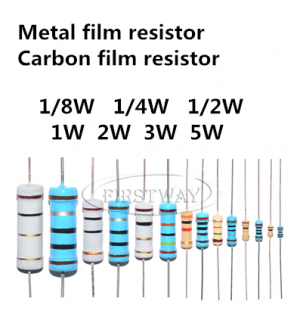

The resistor colour code markings are always read one band at a time starting from the left to the right, with the larger width tolerance band oriented to the right side indicating its tolerance. It consists of a set of individual coloured rings or bands in spectral order representing each digit of the resistors value. These coloured painted bands produce a system of identification generally known as a Resistors Colour Code.Īn international and universally accepted resistor colour code scheme was developed many years ago as a simple and quick way of identifying a resistors ohmic value no matter what its size or condition. So to overcome this, small resistors use coloured painted bands to indicate both their resistive value and their tolerance with the physical size of the resistor indicating its wattage rating. But when the resistor is small such as a 1/4 watt carbon or film type, these specifications must be shown in some other manner as the print would be too small to read. If you in need of 10k resistors, you better buy it with large number since it is often used in many applications and considered as the most common resistor.The resistance value, tolerance, and wattage rating are generally printed onto the body of the resistor as numbers or letters when the resistors body is big enough to read the print, such as large power resistors. It means the resistance will range from 9.5k to 10.5k ohm. The 5% is the tolerance from the gold band. If we use a multimeter or ohmmeter we will get the resistance of 10k ±5%. Just as mentioned, the color code is brown – black – orange – gold. The resistance is : (1) (0) (x1000) (±5%) = 10k ±5% ohm Real Picture of 10k Ohm Resistorīelow is the real picture of a 10k ohm resistor. The fourth band is gold, it means the tolerance is +- 5%. The third band is orange, it means the multiplier is 1000 or 1K. The second band is black, it means the second digit is 0. The first band is brown, it means the first digit is 1. The resistance above is 10K ohm and the explanation of its bands can be seen below: Band The bigger its size, the bigger its power rating. The body color doesn’t have any meaning, but the size will determine the power rating. The size and the color may differ from one to another. Observe the image below is the illustration of a 10k ohm resistor. We can look at the picture below and compare it with the chart above. For easier explanation, observe the table below:įrom the chart above, we can easily understand what colors we need to find in order to get 10k ohm resistors. From the resistor color code for 4 bands chart, the first two bands indicate the number, the third band indicates the multiplier, and the fourth band indicates the tolerance. In this case we will use resistor color code for 4 bands. It means the resistor has resistance of 10,000 ohm. Without further ado we will learn what is the 10k ohm resistor color code or 10 kilo ohm resistor color code. This resistor color code standard follows the IEC60062 used by worldwide applications. We can learn about this resistor color code easily when searching about “Resistor Color Code Chart”.

Each band has their own number to form a resistance number. Resistor color code can be formed with 3, 4, or 5 color bands. Resistor color code is a color code to indicate the resistance of that resistor.
100 OHMS RESISTOR COLOR CODE HOW TO
Now we will learn how to get a 10k ohm resistor color code. It provides a specific resistance to the circuit.

10K / 10K Ohm Resistor Color Code – A resistor is a fundamental passive component for an electrical circuit.


 0 kommentar(er)
0 kommentar(er)
